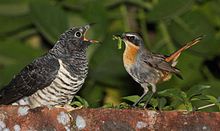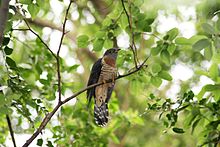Hermit Cuckoo
| Hermit Cuckoo | ||||||||||
|---|---|---|---|---|---|---|---|---|---|---|

Hermit cuckoo ( Cuculus solitarius ) |
||||||||||
| Systematics | ||||||||||
|
||||||||||
| Scientific name | ||||||||||
| Cuculus solitarius | ||||||||||
| Stephens , 1815 |
The hermit cuckoo ( Cuculus solitarius ) belongs to the order of the cuckoo birds (Cuculiformes) and to the family of the cuckoos (Cuculidae).
The hermit cuckoo occurs in the Afrotropic ecozone . Like many species of cuckoos, it is a compulsory brood parasite. Despite its large distribution area, the hermit cuckoo is considered to be monotypical .
The population of the hermit cuckoo is given as LC (= least concern - not endangered), as it is a common bird in parts of its range.
features
The hermit cuckoo reaches a body length of 31 centimeters. It is a long-tailed cuckoo with an average tail length of 14.8 centimeters. The cuckoo's beak has an average length of 1.5 centimeters. Males weigh between 68 and 90 grams, the females weigh between 67 and 74 grams.
The male is dark slate gray on the upper side of the body, the reins and the ear covers are pale gray. The inner flags of the hand wings are sparred in white except for the feathers. The arm wings, on the other hand, are monochrome dark gray. The under-swinging ceilings are brown and black-brown sparred. The throat is pale gray. The breast is cinnamon-colored to reddish brown and is clogged in many individuals. The rest of the underside of the body is pale brownish to creamy white with a dense black-brown sparrow coat. The control feathers are dark slate gray with white spots along the nib shafts.
The females differ from the males by a less brownish breast and by a denser sparrow coat. Individual individuals are completely corked.
Fledglings are blackish on the upper side of the body, the back of the head is white. The wings are slate black with a thin cinnamon-colored sparrow on the inside flags of the hand wings. The large wing covers are dotted white on the outer flags. From the throat to the front breast, the plumage is black with white spots. In some individuals there is also a slight sparrowing . Otherwise, the underside of the body is black and creamy white pimped up to the tail-coverts. The tail is black with a white tip and white spots.
The iris is brown to dark brown in adult birds. Young birds have a black iris. The eyelid is olive green with a yellow orbital ring.
Distribution area
The hermit cuckoo is a breeding bird of the Afrotropic ecozone, which occurs as an intra-African migratory bird in almost all of sub-Saharan Africa . It is only missing in the arid regions of southwest Africa and the Horn of Africa. In the east of Africa the migration of the hermit cuckoo is determined by the rainy season. In Ethiopia, the hermit cuckoo is found year round, but an increase in populations at the beginning of May indicates migrating birds of this species. It is also a resident bird in the regions of the tropical rainforest in West Africa. In the northern savannas it can be found from the end of the dry season to the end of the rainy season.
In east Africa, the hermit cuckoo is just a seasonal bird. On the coast of Tanzania and Kenya he stays in the period from October to April, in the interior and in the southeast of Tanzania, however, in the period from October to March. In the south of Uganda, on the other hand, he is present from November to March.
habitat
The hermit cuckoo lives in the thickly tree-lined, damp savannah, in gallery forests and in forests and thickets along rivers. It also inhabits evergreen tropical forests, semi-arid acacia forests and is also found in gardens. Basically he avoids extremely dry areas. Typical of the regions populated by the hermit cuckoo is an annual rainfall of more than 500 millimeters.
Its height distribution extends up to 3000 meters. In the east of Africa it is usually found between 1000 and 3000 meters above sea level, but also occurs at sea level in the coastal regions.
food
Like many other cuckoo species, the hermit cuckoo prefers to eat hairy caterpillars. These are usually avoided by other bird species. It also eats beetles, flying ants, grasshoppers, spiders, centipedes , earwigs, snails, small frogs, lizards and berries.
The species that the hermit cuckoo uses as host bird also feed the nestlings in their nests with a wide range of different insects, spiders, snails, centipedes, earwigs, frogs, lizards and berries. The caprod , which is a common host bird of the hermit cuckoo in South Africa, also feeds the nestlings with very hairy caterpillars, which are normally not part of its diet.
Brood Parasitism

The hermit cuckoo is a must-have brood parasite. It uses a number of different host bird species in its large area of distribution. Busy is a parasitism in areas such as olive thrush , Mocking , Cape Sparrow , mountain wagtail , Cape Robin-Chat and Cape Wagtail .
The color of the eggs is very variable: Erhitzøe assumes two to eight different female host-specific lines, in which the cuckoo eggs are adapted to those of the respective host and which is maintained by the female hermit cuckoo's strong preference for certain host bird species. The same is with the also in Central Europe occurring cuckoo well studied. This so-called egg mimicry can be found in many brood parasitic cuckoos. It is one of the strategies to ensure that the host bird species does not remove or peck at the foreign egg in the clutch.
The most common color of the eggs in the hermit cuckoo is a uniform brown or olive color, but pale green, olive green, pale blue or reddish brown speckled eggs are also known. The nestlings of the hermit cuckoo hatch after a breeding season of 11 to 16 days. They throw the eggs and nestlings of their host bird parents out of the nest within their first two days of life. They fledge at 17 to 22 days of life, but are dependent on being fed by the host bird parents for another 20 to 25 days.
Hermit cuckoo and human
The hermit cuckoo has a loud, fluting song made up of three equally long tones. Similar to the call of the cuckoo, which is widespread in Central Europe , is associated with spring, the hermit cuckoo in Africa heralds the onset of rain and thus the beginning of cultivation.
literature
- Mark Cocker, David Tipling: Birds and People. Jonathan Cape, London 2013, ISBN 978-0-2240-8174-0 .
- NB Davies: Cuckoos, Cowbirds and Other Cheats. T & AD Poyser, London 2000, ISBN 0-85661-135-2 .
- Johannes Erhitzøe, Clive F. Mann, Frederik P. Brammer, Richard A. Fuller: Cuckoos of the World. Christopher Helm, London 2012, ISBN 978-0-7136-6034-0 .
Web links
Single receipts
- ↑ a b c d e Erhitzøe, Mann, Brammer, Fuller: Cuckoos of the World . P. 453.
- ↑ a b c d e Erhitzøe, Mann, Brammer, Fuller: Cuckoos of the World . P. 451.
- ↑ Erhitzøe, Mann, Brammer, Fuller: Cuckoos of the World . P. 452.
- ↑ Mark Cocker, David Tipling: Birds and People . Jonathan Cape, London 2013, ISBN 978-0-2240-8174-0 . P. 268


